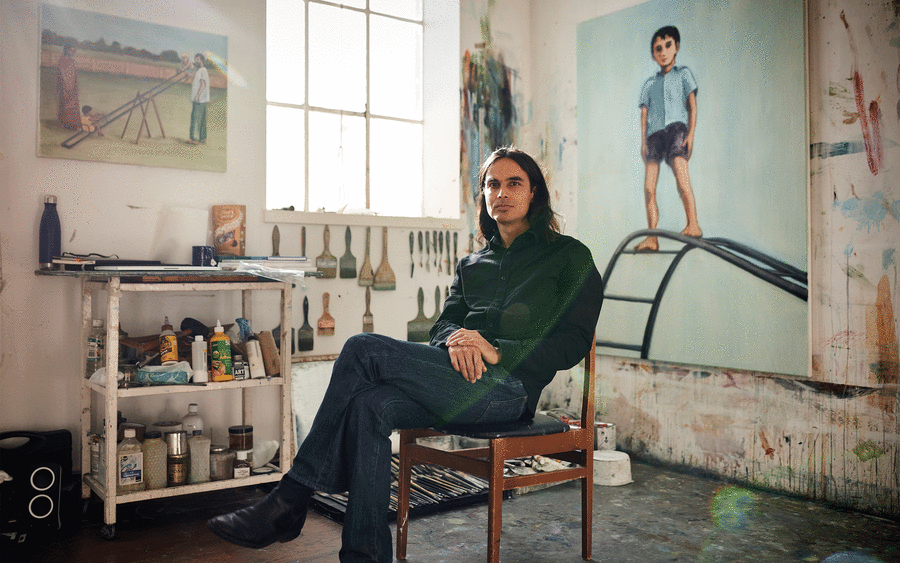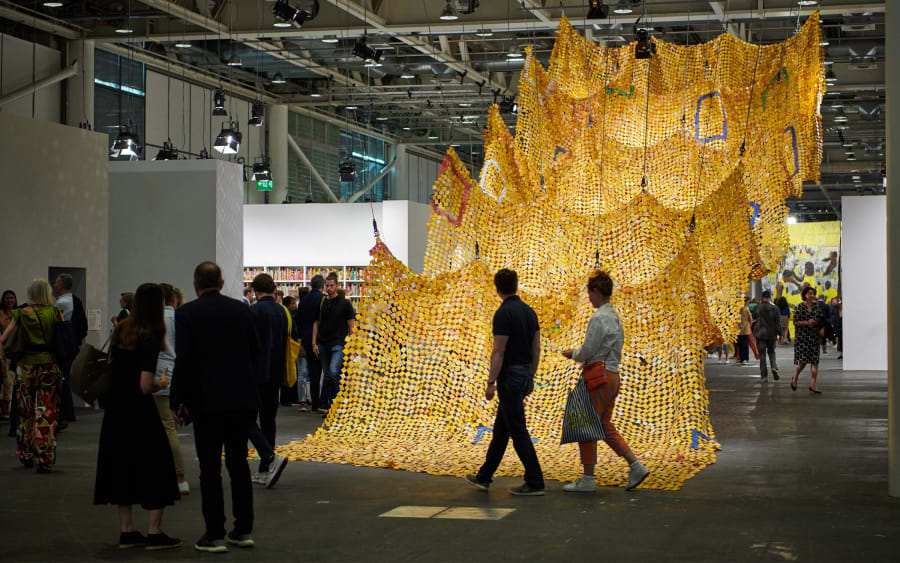Drag is everywhere – and has been for longer than one might think. Ubiquitous in pop culture and in locally staged performances the world over, it also reaches the museum. Of course, from Marcel Duchamp’s drag persona Rrose Sélavy to RuPaul’s Drag Race on television, drag has never been far from fine art or popular appreciation.
Drag is profound: A simple notion of ‘cross-dressing’ barely touches the unbridled creative possibilities that come with modifying the appearance of the self and exploring alternative identities. One doesn’t need to read esoteric theory to understand RuPaul, arguably the world’s most famous drag performer, when he says, ‘we’re all born naked and the rest is drag’ – and the kaleidoscopic array of possibilities such a statement offers. Several artists have explored them; in this article, we survey some of the most compelling voices addressing the subject.
There are countless approaches to a living art like drag. In Haarlem, The Netherlands, the Frans Hals Museum currently displays both historic and contemporary examples thereof, in a show titled 'The Art of Drag'. The oldest pieces in the exhibition are paintings of the Dutch festival Hartjesdag (Day of Hearts), which, sometime between the Middle Ages and the 19th century, evolved from an exaltation of deer hunting to one of drag revelry. A realist Hartjesdag (1926) by Johan Coenraad Braakensiek is a detailed, joyous street scene, while a more impressionistic Hartjesdag (1890–95) by Jacobus van Looy reflects the vagaries of gender identities with its blurring of light and shadow. Meanwhile, Ferdinand Erfmann’s up-close depictions of dressing in drag, drawn from the artist’s own life, are direct yet intimate. The nonbinary, multi-racial subjects of his Dance bar (1928) hold each other with calm confidence. It’s a far cry from the leery decadence of his peers associated with Neue Sachlichkeit.
In the 20th century, as technologies like photography and video converged with the increasing prevalence of performance in fine art contexts, and as mainstream sensibilities more openly embraced the non-normative, drag proliferated. Many artists who documented drag culture in the spotlight, behind the scenes, and via myriad small moments of daily life, have only recently received substantial institutional recognition.
In New York, Chinese-Spanish-Filipino-American artist and activist, Agosto Machado (b. 1940s, USA), has been active since the late 1960s and spent decades preserving ephemera from beloved members of his community, including LGBTQIA+ rights activist Marsha P. Johnson and performer Ethyl Eichelberger, many lost to such consequences of marginalization as violence, addiction, and AIDS. Precious objects, snapshots, newspaper clippings, and figurines fill Machado’s singular archive, as exemplified by his ‘Shrines’ series - including Shrine (White) (2022), in the collection of the Museum of Modern Art, New York.
In California, Reynaldo Rivera (b. 1964, Mexicali, Mexico) has taken pictures since the late 1970s of friends, family, and brief encounters, often featuring drag performers or joyfully extravagant characters. His images encapsulate the gamut of living in Queer, Latinx Los Angeles through the AIDS era of the 1980s, 1990s, and beyond, from classic shots of nightlife like Elyse Regehr and Javier Orosco, Downtown LA (1989), to glimpses of hushed intimacy like Bianco, Echo Park (1992).
Photography allows artists not just to document drag, but to explore its conceptual limits. Back at the Frans Hals Museum, one can see works by Sarah Lucas (b. 1962, London) that poke fun at the gender codes attached to clothing, posture, and mundane food objects, as in Self Portrait with Fried Eggs (1996) or Eating a Banana (1990). Also included are selections from the series of photographs by Gillian Wearing (b. 1963, Birmingham, UK) of herself dressed up, complete with prosthetics, as other famous artists, like Me as Mapplethorpe (2009).
In the work of Dutch artist Julius Thissen (b. 1993, Netherlands), also on view in Haarlem, photography is pushed yet further against gender normativity. Their series ‘A Gentle Decompression’ (2021) incorporates themes of trans bodily autonomy, mental health, and the persistence of rigid gender tropes in fashion design. In one of the images, A Body Surveilled, the artist is pictured, slightly out of focus, dressed in a sheer, masculine-coded suit, their body visible through the fabric. In another work, Bear No Name (2022), Thissen is shown in a conventionally masculine suit, but this one is oversized, and the artist is wearing it backwards, the back of their head to the camera while the suit faces it front-on. ‘I was in the financial district of Amsterdam,’ Thissen says, ‘and saw all of these men – who are supposed to be self-made individuals – wearing the same kind of suit, as if they were harnesses for neoliberalism.’ They describe the photo as an attempt to interrupt the lineage of men who have worn suits to enact power through history, to perpetuate patriarchy, colonialism, and capitalism – an unconventional example of drag’s subversive potential.
Video, meanwhile, can capture drag performance in a way that static images can’t, and gives opportunities for experimentation with sound and narration that extend and amplify the performance. The canonical video work of Charles Atlas (b. 1949, St. Louis, MO, US), in which he combines the sheer joy of documenting his friends with visual abstraction and installation, spans decades. The exhibition has his classic What I Did Last Summer (1991) as well as his more recent vision of the iconic drag queen Lady Bunny in Here She Is…v1 (2015).
Based in London and also participating in the Frans Hals show, Sin Wai Kin (b. 1991, Toronto, Canada) is at the vanguard of video strategies in pieces like Tell me everything you saw, and what you think it means (2018), in which the artist’s voiceover captures the viewer’s attention as it repeats, ‘She looks…she looks so…’ and the camera peers at them. More recent works, like The Breaking Story (2022) and Dreaming the End (2023), incorporate genre tropes from science fiction and Chinese opera to illustrate the many personae that populate the artist's oeuvre – almost always in drag.
The expansion on drag’s basic premises hasn’t only happened on screen: rafa esparza (b. 1981, Los Angeles, USA) has used painting, sculpture, and performance to do so. For Corpo Ranfla (2018), he collaborated with fellow LA artists to paint his body as if it were a lowrider automobile. With bright pink paint, twinkling gold, and a stenciled picture of the iconic drag elder, Cyclona, on his chest, esparza played with the car and Queer resonances of ‘drag’ and ‘cruising’, effectively emphasizing how drag is not bound by the binary of ‘male’ and ‘female’. He took this even further for his performance as a cyborgian lowrider, Corpo RanfLA: Terra Cruiser (2022), his body embedded in a wheeled sculptural apparatus that people could actually ride at Art Basel Miami Beach. These high-concept works resonate with esparza’s many paintings made on adobe brick which remains in part visible. They all play with the relation between raw, unadorned material, and the marks and meanings bestowed upon it. The large-scale Trucha (2024), shows an unclothed figure in bed, as if snuck up upon from behind, surrounded by private ornamentations of the self that nonetheless connect with the impositions of history and the outside world: books on anti-colonial struggle, symbols of indigeneity, an iPhone.
American artists such as Atlas, esparza, and the young Devan Shimoyama (b. 1989, Philadelphia, PA) have been particularly keen to explore the more exuberant aspects of drag. Shimoyama deploys drag techniques within his paintings. He twists conventions of portraiture with eye-grabbing color juxtapositions, collage, and allusions to Queerness, Black culture, and mythology. The sequins, beads, and shiny lips in Euryale (2024) dress the painting in drag, turning the Gorgon sister into someone whose ornately beaded eyes you might actually want to meet. With rhinestones and glitter, Kory (2023) evokes proud androgyny in the customarily masculine setting of the Black barbershop. In Self-Portrait as Mystique (2022), the artist’s own face becomes that of the titular shape-shifting superhero character from X-Men – but you don’t need to catch the reference to appreciate the transformation of Shimoyama’s persona beyond the strictures of masculinity and femininity.
As the in-jokes, references, and persistent appreciation of elders and influence attest, the inherently social orientation of drag means that it is all about finding and making community. Back at the Frans Hals Museum, Yamuna Forzani (b. 1993, UK) emphasizes the centrality of cultivating kinship and her creative practice’s entwinement with drag and Queer culture. ‘Why should someone working alone in their studio be valued more than someone who works primarily in their community?’ she asks.
With a background in fashion design and a devoted involvement to the ballroom scene, Forzani has extended her facility for gender-tweaking clothing to wall-hung artworks like Caress (2022) – a tapestry knitted using a technique usually intended for mattress tops, it depicts a figure bound in rope, draped in flowers, leaning back in pink-hued ecstasy or resignation. Other pieces present people in similar states of reverie, often in groups that blend with the texture of the knitting as much as they tangle with each other, as in the neon-laced aqueous blue scene of It takes a village (2023).
Drag, like Queer culture, is nothing new, but its prevalence and influence grows and grows. It’s now been 60 years since Susan Sontag wrote in her seminal essay, ‘Notes on “Camp”’ (1964), that to understand being in the world is to understand ‘Being-as-Playing-a-Role’. As drag continues to excite the popular imagination, a celebration of its ongoing history like the exhibit in Haarlem welcomes us to the simple, radical challenge to find agency and community in the ways we become ourselves.
Nicholas Nauman is a writer based in Los Angeles.
Caption for top image: Devan Shimoyama, Transformation Sequence 1 (detail) 2021. Presented at Art Basel Miami Beach 2021 by Kavi Gupta.
Caption for top image on homepage: Charles Atlas, Here She Is…v1 (detail), 2015. © Charles Atlas; courtesy of the artist and Luhring Augustine.


